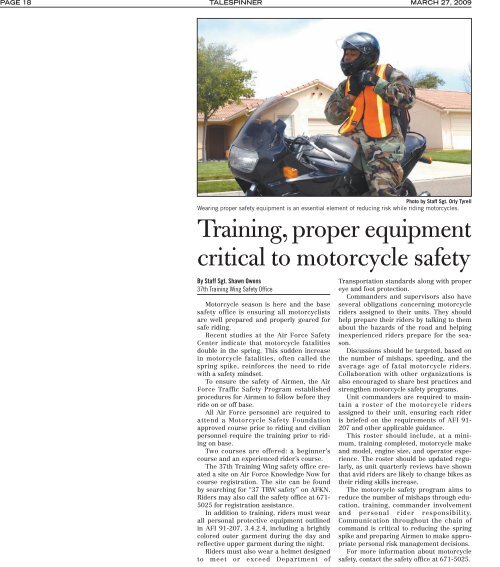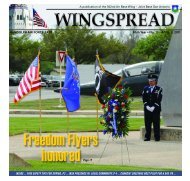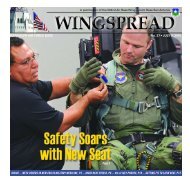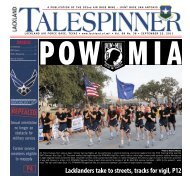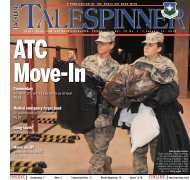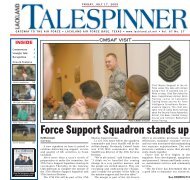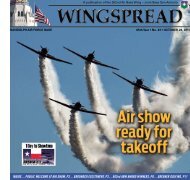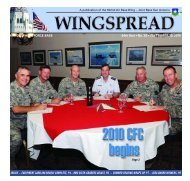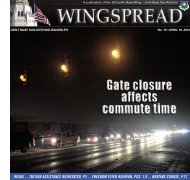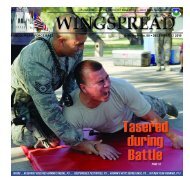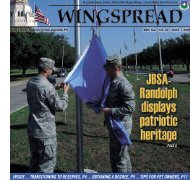AGE 18 TALESPINNERMARCH 27, 2009Photo by Staff Sgt. Orly TyrellWear<strong>in</strong>g proper safety equipment is an essential element of reduc<strong>in</strong>g risk while rid<strong>in</strong>g motorcycles.Tra<strong>in</strong><strong>in</strong>g, proper equipmentcritical to motorcycle safetyBy Staff Sgt. Shawn Owens37th Tra<strong>in</strong><strong>in</strong>g W<strong>in</strong>g Safety OfficeMotorcycle season is here and the basesafety office is ensur<strong>in</strong>g all motorcyclistsare well prepared and properly geared forsafe rid<strong>in</strong>g.Recent studies at the Air Force SafetyCenter <strong>in</strong>dicate that motorcycle fatalitiesdouble <strong>in</strong> the spr<strong>in</strong>g. This sudden <strong>in</strong>crease<strong>in</strong> motorcycle fatalities, often called thespr<strong>in</strong>g spike, re<strong>in</strong>forces the need to ridewith a safety m<strong>in</strong>dset.To ensure the safety of Airmen, the AirForce Traffic Safety Program establishedprocedures for Airmen to follow before theyride on or off base.All Air Force personnel are required toattend a Motorcycle Safety Foundationapproved course prior to rid<strong>in</strong>g and civilianpersonnel require the tra<strong>in</strong><strong>in</strong>g prior to rid<strong>in</strong>gon base.Two courses are offered: a beg<strong>in</strong>ner’scourse and an experienced rider’s course.The 37th Tra<strong>in</strong><strong>in</strong>g W<strong>in</strong>g safety office createda site on Air Force Knowledge Now forcourse registration. The site can be foundby search<strong>in</strong>g for “37 TRW safety” on AFKN.Riders may also call the safety office at 671-5025 for registration assistance.In addition to tra<strong>in</strong><strong>in</strong>g, riders must wearall personal protective equipment outl<strong>in</strong>ed<strong>in</strong> AFI 91-207, 3.4.2.4, <strong>in</strong>clud<strong>in</strong>g a brightlycolored outer garment dur<strong>in</strong>g the day andreflective upper garment dur<strong>in</strong>g the night.Riders must also wear a helmet designedto meet or exceed Department ofTransportation standards along with propereye and foot protection.Commanders and supervisors also haveseveral obligations concern<strong>in</strong>g motorcycleriders assigned to their units. They shouldhelp prepare their riders by talk<strong>in</strong>g to themabout the hazards of the road and help<strong>in</strong>g<strong>in</strong>experienced riders prepare for the season.Discussions should be targeted, based onthe number of mishaps, speed<strong>in</strong>g, and theaverage age of fatal motorcycle riders.Collaboration with other organizations isalso encouraged to share best practices andstrengthen motorcycle safety programs.Unit <strong>commander</strong>s are required to ma<strong>in</strong>ta<strong>in</strong>a roster of the motorcycle ridersassigned to their unit, ensur<strong>in</strong>g each rideris briefed on the requirements of AFI 91-207 and other applicable guidance.This roster should <strong>in</strong>clude, at a m<strong>in</strong>imum,tra<strong>in</strong><strong>in</strong>g completed, motorcycle makeand model, eng<strong>in</strong>e size, and operator experience.The roster should be updated regularly,as unit quarterly reviews have shownthat avid riders are likely to change bikes astheir rid<strong>in</strong>g skills <strong>in</strong>crease.The motorcycle safety program aims toreduce the number of mishaps through education,tra<strong>in</strong><strong>in</strong>g, <strong>commander</strong> <strong>in</strong>volvementand personal rider responsibility.Communication throughout the cha<strong>in</strong> ofcommand is critical to reduc<strong>in</strong>g the spr<strong>in</strong>gspike and prepar<strong>in</strong>g Airmen to make appropriatepersonal risk management decisions.For more <strong>in</strong>formation about motorcyclesafety, contact the safety office at 671-5025.
AGE 20 TALESPINNERMARCH 27, 2009ASIAN PACIFIC AMERICAN HERITAGECOMMITTEEThe Asian Pacific AmericanHeritage Committee will meet today,1 p.m., <strong>in</strong> the claims office conferenceroom <strong>in</strong> 37th Tra<strong>in</strong><strong>in</strong>g W<strong>in</strong>gheadquarters to discuss May eventscelebrat<strong>in</strong>g Asian Pacific Americanmonth at <strong>Lackland</strong>.Contact Capt. Thomas Smith at671-3365 for more <strong>in</strong>formation.DEPLOYED FAMILY SUPPORTThe Family Service Association issponsor<strong>in</strong>g a deployed family supportgroup at Freedom Chapel beg<strong>in</strong>n<strong>in</strong>gMonday and runn<strong>in</strong>g for eightweeks.The group will provide a place forfamilies to connect, address re<strong>in</strong>tegrationissues, parent<strong>in</strong>g supportand cop<strong>in</strong>g with deployment stress.For more <strong>in</strong>formation or reservations,contact Amber Alexander at381-3933.PARENTING CLASS SETThe Precious M<strong>in</strong>ds NewConnections program beg<strong>in</strong>sTuesday at the Gateway ChildDevelopment Center.The course is an enrichment programfor parents, grandparents, fosterparents and step-parents of childrenup to 3 years of age.The classes run for eight weeks,meet<strong>in</strong>g Tuesdays from 6-9 p.m.Childcare and a light meal are provided.Contact Miguel Alvarez at 678-2989 for reservations.CANCER RESOURCE CENTERA cancer resource center dedicatedto patient care and education willopen Tuesday <strong>in</strong> the basement ofWilford Hall Medical Center.More than 130 pamphlets with<strong>in</strong>formation of a wide variety of cancerrelated topics will be availablealong with a search service on specifictopics.The center is open 1-4:30 p.m.Tuesdays, and 9-11 a.m. and 12:30-3 p.m. Thursdays.For more <strong>in</strong>formation, call 292-4808.FOSTER PARENT, ADOPTIONWORKSHOPThe Airmen and FamilyRead<strong>in</strong>ess Flight will jo<strong>in</strong> with theChildren’s Shelter to sponsor a workshopThursday, 6-8 p.m., <strong>in</strong> Bldg.1249 to offer <strong>in</strong>formation about fosterparents and adoption.Many of the children <strong>in</strong> the shelterhave been removed from theirCOMMUNITYLocalBRIEFSparents because of abuse or neglect.The children also may have beendiagnosed with physical, emotionalor mental limitations; hard to placebecause of age; an ethic m<strong>in</strong>ority; orpart of a large sibl<strong>in</strong>g group.For <strong>in</strong>formation or reservations,call the AFRF at 671-3722.DOG OBEDIENCE CLASSESDog obedience classes will beg<strong>in</strong>April 6 at Arnold Hall CommunityCenter.Puppy class will be held from 6-6:55 p.m. and beg<strong>in</strong>ner class from7-7:55 p.m.The first class is for the ownerswithout their dog.Puppy class participants willneed a leash, collar and a baggie ofCheerios for each class.For more <strong>in</strong>formation, call 671-2619.SERVICE OPPORTUNITYThe American Society of MilitaryComptrollers will sponsor volunteerservice hours at the Sunsh<strong>in</strong>e PlazaApartments, 455 E. Sunsh<strong>in</strong>e Drive,from 9 a.m. to noon April 18 withlight clean<strong>in</strong>g for senior residents.Students can earn a communityservice certificate for up to threehours for participat<strong>in</strong>g.To volunteer, contact AndreaPowers at 221-2752 or Nida Soriano-Rosas at 536-7234.ZERO OVERPRICING PROGRAMA successful zero overpric<strong>in</strong>g programchallenge can save the AirForce money and put extra cash <strong>in</strong>toyour pocket.For an overpriced item challenge<strong>in</strong> the AF standard base supply system<strong>in</strong>ventory, items can be submittedby us<strong>in</strong>g Form 1046, zero overpric<strong>in</strong>gchallenge/referral, to the37th Tra<strong>in</strong><strong>in</strong>g W<strong>in</strong>g LogisticsRead<strong>in</strong>ess Squadron, customer servicesection.A successful challenge will result<strong>in</strong> the difference be<strong>in</strong>g reimbursed.For more <strong>in</strong>formation, call 671-2575.WHMC TO CONDUCT STUDYWilford Hall Medical Center<strong>in</strong>vites all Air Force military memberswho have previously deployed to participate<strong>in</strong> a study research<strong>in</strong>gimportant psychological factors possiblyrelated to psychological riskand resilience across the deploymentcycle.WHMC is seek<strong>in</strong>g health carepersonnel – nurses, technicians,physicians, adm<strong>in</strong>istrative staff, andancillary services – who havereturned from a deployment to theAir Force Theater Hospital <strong>in</strong> Iraq toparticipate <strong>in</strong> 1-hour focus groups.These focus groups will be voluntaryand no personal identify<strong>in</strong>g <strong>in</strong>formationwill be obta<strong>in</strong>ed from any participant.The 60-m<strong>in</strong>ute focus groups willbe conducted at various dates, timesand locations with<strong>in</strong> WHMC.For more <strong>in</strong>formation and to signup for a focus group session, call562-5408.See BRIEFS P21To see menus for<strong>Lackland</strong> d<strong>in</strong><strong>in</strong>ghalls, go onl<strong>in</strong>e towww.lackland.af.miland click on the“Services“ l<strong>in</strong>k.CHAPEL SERVICESChristianCatholicMonday-Friday:WHMC ChapelMass, 11 a.mWednesday-Friday:Freedom ChapelMass, 11:30 a.m.Saturday:Freedom ChapelConfessions, 4:45 p.m.Mass, 5:30 p.m.Sunday:Freedom ChapelReligious Education, 9 a.m.Mass, 11 a.m.Hope ChapelHispanic Mass, 9:15 a.m.Wilford Hall Medical Center ChapelMass, 3 p.m.OrthodoxSunday:Airmen Memorial ChapelDiv<strong>in</strong>e Liturgy, 9:30 a.m.Religious Education, 10:45 a.m.ProtestantSunday:Airmen Memorial ChapelLiturgical Service, 8 a.m.Hope ChapelSpanish Service, 12:45 p.mFreedom ChapelContemporary Service, 9:30 a.m.Gospel Service, 12:30 p.m.Children’s Church providedReligious Education, 11 a.m.Wednesday and Thursday:Bible Study, 6 p.m.Sunday:Med<strong>in</strong>a ChapelContemporary Service, 10:30 a.m.WHMC ChapelGeneral Service, 1:30 p.m.IslamicFriday:Defense Language InstituteStudent CenterFaith Study, 1:30 p.m.Jummah Prayer, 2 p.m.JewishFriday:Airmen Memorial ChapelSabbath Eve Service,6 p.m.WiccaWednesday(1st only):Freedom Chapel,Room 8, SanAntonio Military Open Circle,6:30 p.m.For more <strong>in</strong>formation,contact the chapel staff:Freedom Chapel671-4208Gateway Chapel671-2911Hope Chapel671-2941Wilford Hall MedicalCenter Chapel292-7373
- Page 1 and 2: FRIDAY, MARCH 27, 2009GATEWAY TO TH
- Page 3 and 4: MARCH 27, 2009TALESPINNERPAGE 3News
- Page 5 and 6: MARCH 27, 2009TALESPINNERPAGE 5Rema
- Page 7 and 8: MARCH 27, 2009TALESPINNERPAGE 7Base
- Page 9 and 10: MARCH 27, 2009TALESPINNERPAGE 9SECU
- Page 11 and 12: MARCH 27, 2009TALESPINNERPAGE 11LAC
- Page 13 and 14: MARCH 27, 2009TALESPINNERPAGE 13Ful
- Page 15 and 16: MARCH 27, 2009TALESPINNERPAGE 15COU
- Page 17: MARCH 27, 2009Base celebrates child
- Page 21 and 22: AGE 22 TALESPINNERMARCH 27, 2009SCO


